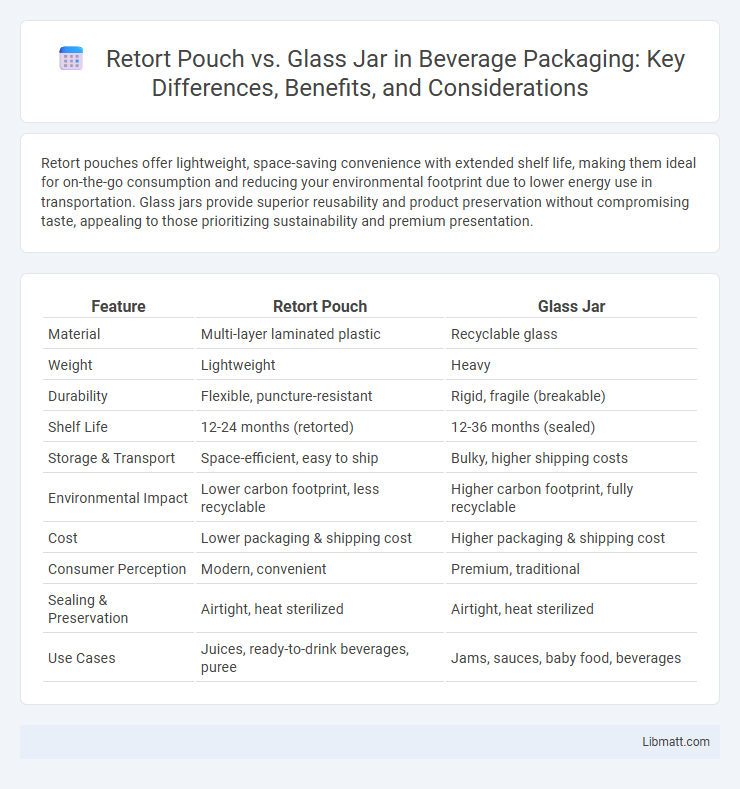Retort pouches offer lightweight, space-saving convenience with extended shelf life, making them ideal for on-the-go consumption and reducing your environmental footprint due to lower energy use in transportation. Glass jars provide superior reusability and product preservation without compromising taste, appealing to those prioritizing sustainability and premium presentation.
Table of Comparison
| Feature | Retort Pouch | Glass Jar |
|---|---|---|
| Material | Multi-layer laminated plastic | Recyclable glass |
| Weight | Lightweight | Heavy |
| Durability | Flexible, puncture-resistant | Rigid, fragile (breakable) |
| Shelf Life | 12-24 months (retorted) | 12-36 months (sealed) |
| Storage & Transport | Space-efficient, easy to ship | Bulky, higher shipping costs |
| Environmental Impact | Lower carbon footprint, less recyclable | Higher carbon footprint, fully recyclable |
| Cost | Lower packaging & shipping cost | Higher packaging & shipping cost |
| Consumer Perception | Modern, convenient | Premium, traditional |
| Sealing & Preservation | Airtight, heat sterilized | Airtight, heat sterilized |
| Use Cases | Juices, ready-to-drink beverages, puree | Jams, sauces, baby food, beverages |
Introduction to Retort Pouch and Glass Jar Packaging
Retort pouches offer lightweight, flexible packaging made from multi-layer laminated films designed to withstand high-temperature sterilization, extending shelf life without refrigeration. Glass jars provide rigid, impermeable containers that preserve food quality and flavor while allowing easy visualization of contents, commonly used for jams, sauces, and preserves. Both packaging types prioritize durability and food safety, with retort pouches excelling in convenience and transport efficiency, and glass jars favored for recyclability and product display.
Material Composition and Structure
Retort pouches consist of multiple layers of laminated materials such as aluminum foil, plastic films, and polyester, providing a lightweight, flexible, and durable barrier against moisture, oxygen, and light. Glass jars are made of thick, inert silica-based material, offering superior chemical resistance and impermeability but at the cost of increased weight and fragility. Your choice depends on whether you prioritize the convenience of retort pouches or the traditional preservation quality and reusability of glass jars.
Packaging Process Overview
Retort pouches undergo a high-temperature, high-pressure sterilization process that involves sealing food inside flexible, multi-layered laminated films, allowing for efficient heat penetration and extended shelf life without refrigeration. Glass jars, on the other hand, require filling with food followed by a strict sterilization process involving steam or hot water immersion to achieve sterilization while ensuring the jar and lid create an airtight seal. The retort pouch's lightweight and flexible structure enables faster heat transfer and reduced processing times compared to the rigid glass jar, which often demands longer heating cycles to ensure safety and product stability.
Shelf Life and Food Preservation
Retort pouches offer extended shelf life by combining heat sterilization with airtight sealing, effectively preserving food nutrients and flavors for up to 12-24 months without refrigeration. Glass jars provide excellent food preservation due to their impermeability to oxygen and moisture, often supporting shelf life ranging from 12 to 36 months depending on the food type and processing method. The lightweight, flexible nature of retort pouches reduces storage space and breakage risk compared to the heavier, fragile glass jars, making them more suitable for large-scale distribution while maintaining comparable preservation quality.
Portability and Storage Efficiency
Retort pouches offer superior portability due to their lightweight and flexible design, making them ideal for on-the-go consumption without adding significant bulk to your belongings. Glass jars, while durable and reusable, are heavier and more fragile, limiting their convenience for travel or limited storage spaces. Their rigid structure requires more space, whereas retort pouches optimize storage efficiency by conforming to available space and reducing shipping and shelf footprint.
Environmental Impact and Sustainability
Retort pouches significantly reduce environmental impact due to their lightweight, lower carbon footprint during transportation, and reduced raw material consumption compared to glass jars. Glass jars, while recyclable and reusable, require higher energy input for production and transportation because of their weight and fragility. The choice between retort pouches and glass jars influences sustainability outcomes, with pouches offering advantages in reducing waste and resource use.
Safety and Product Integrity
Retort pouches use multilayer, heat-resistant materials that provide excellent barrier properties against oxygen and moisture, ensuring extended shelf life while maintaining product safety and integrity. Glass jars are impermeable and non-reactive, offering superior protection from contamination and preserving product flavor and nutritional value without risk of chemical leaching. Both packaging types comply with food safety standards, but retort pouches offer lightweight durability and resistance to breakage, enhancing safety during transportation and storage.
Cost Comparison and Economic Considerations
Retort pouches generally offer lower packaging and transportation costs compared to glass jars due to their lightweight and flexible material, which reduces shipping weight and volume. Glass jars incur higher expenses from fragile handling requirements, increased breakage rates, and heavier weight leading to elevated transportation fees. The economic considerations also include production scalability and shelf-life efficiency, where retort pouches often provide cost savings through extended shelf life and simpler sterilization processes.
Consumer Preferences and Market Trends
Consumer preferences for retort pouches have surged due to their lightweight design, convenience, and extended shelf life compared to traditional glass jars. Market trends indicate a growing demand for sustainable and portable packaging solutions, with retort pouches gaining popularity in ready-to-eat meals and on-the-go food products. Glass jars remain favored for premium products due to their recyclability and perceived quality, though they face challenges in transportation costs and breakage risk.
Choosing the Right Packaging Solution
Retort pouches offer lightweight, space-saving, and cost-effective packaging with excellent shelf life due to high-pressure heat processing, making them ideal for ready-to-eat meals and liquids. Glass jars provide superior product visibility, premium perception, and strong barrier protection but are heavier and more fragile, increasing shipping costs and breakage risk. Choosing the right packaging solution depends on your product's shelf life, transportation logistics, and target market preferences.
Retort pouch vs glass jar Infographic

 libmatt.com
libmatt.com